| A reconnoitre of the Colchester area, August 2018 |
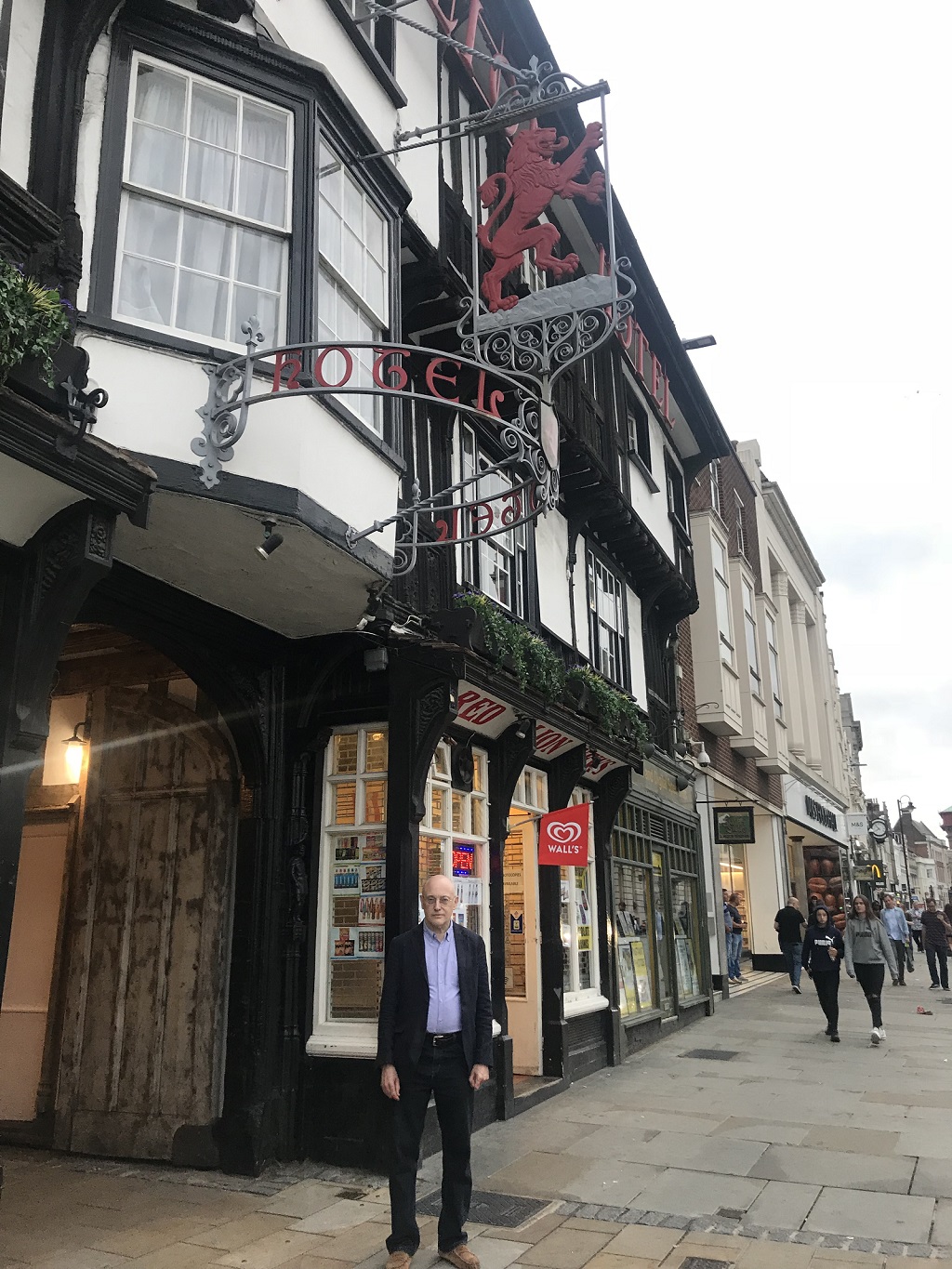
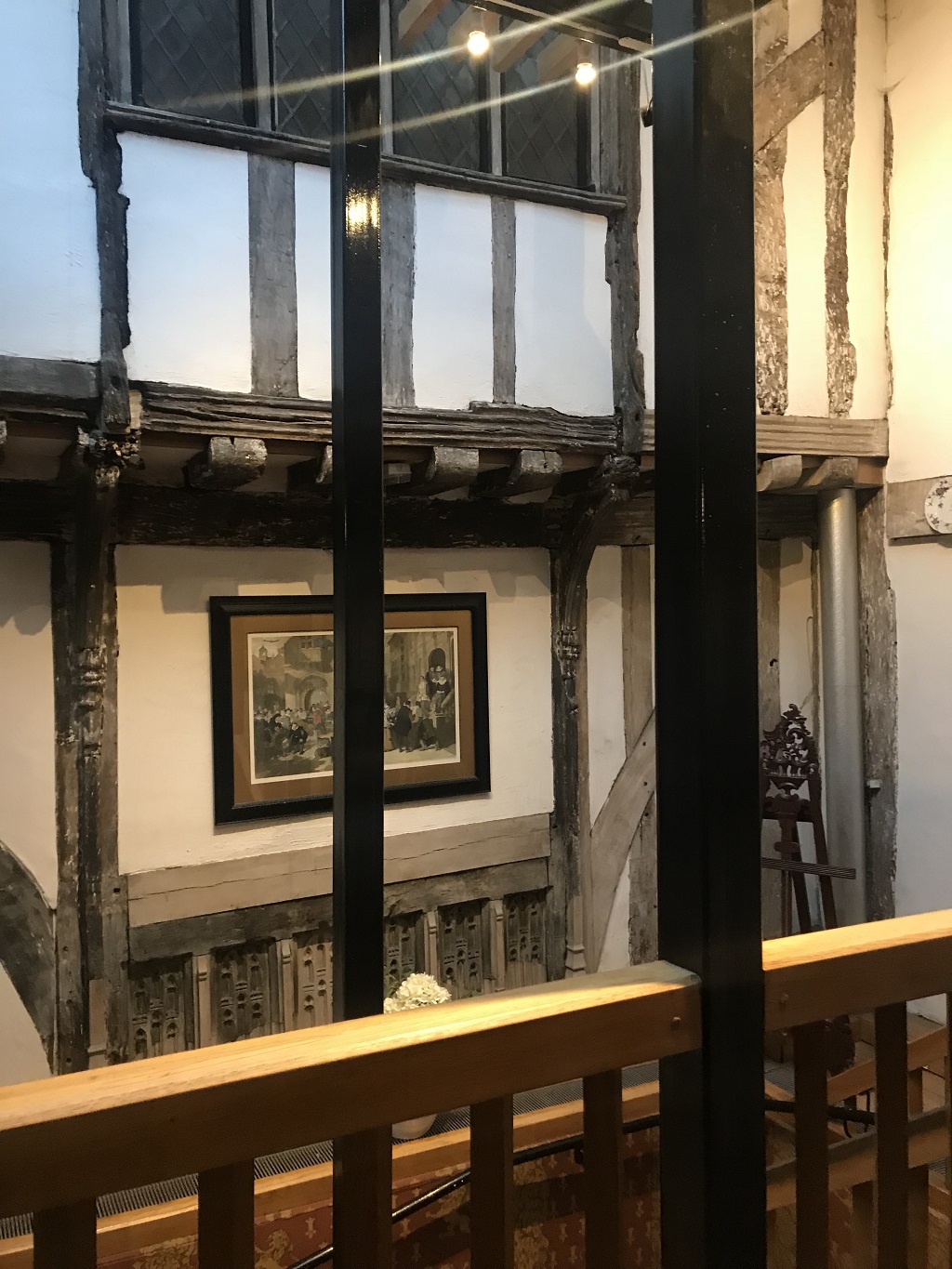
Charles outside the Brook Red Lion (left) and the timber interior (right)
Click on the image to enlarge
On the weekend of 11th/12th August last year, Mike, Golda, Nat and I met up on a slightly rainy Saturday morning to re-trace Colonel Verney’s steps when he took to the field to defeat the evil Canon Copely-Syle in the last third or so of “To The Devil A Daughter”.
In doing so, we paid homage not only to DW but also to ‘Oldjiver’, a member of the Library with whom we have sadly lost contact (I hope he has not died), and who did some sterling research in this area back in 2014. To see his research click here.
Nat and I drove up on the Friday night, and stayed at the Brook Red Lion Hotel, the same as the Red Lion Hotel featured in the novel.
The hotel is a marvellous relic of history which my American friends would consider it a privilege to stay in, as did I. It is Grade 1 listed and was originally built almost certainly as a private mansion, circa 1470, but it became an inn as early as 1500. It is timber framed and I would describe it (with my wife looking askance at me no doubt) as delicious.
One reviewer on Trip Adviser described it memorably as ‘Filthy and Haunted’, but I did not find it so – at least as far as cleanliness is concerned. It is supposed to be haunted but I was not myself accosted by anything from the Astral.
I was however accosted by a different sight. Nat and I had a room at the front, and we were kept awake until 3 o’clock in the morning by something an anthropologist would travel a very great distance to see … the sight of the youth of the town getting legless in preparation for their weekend. And I do mean legless. Very interesting it was, but if you are not into observing humanity at its most relaxed a room at the back might be a good idea.

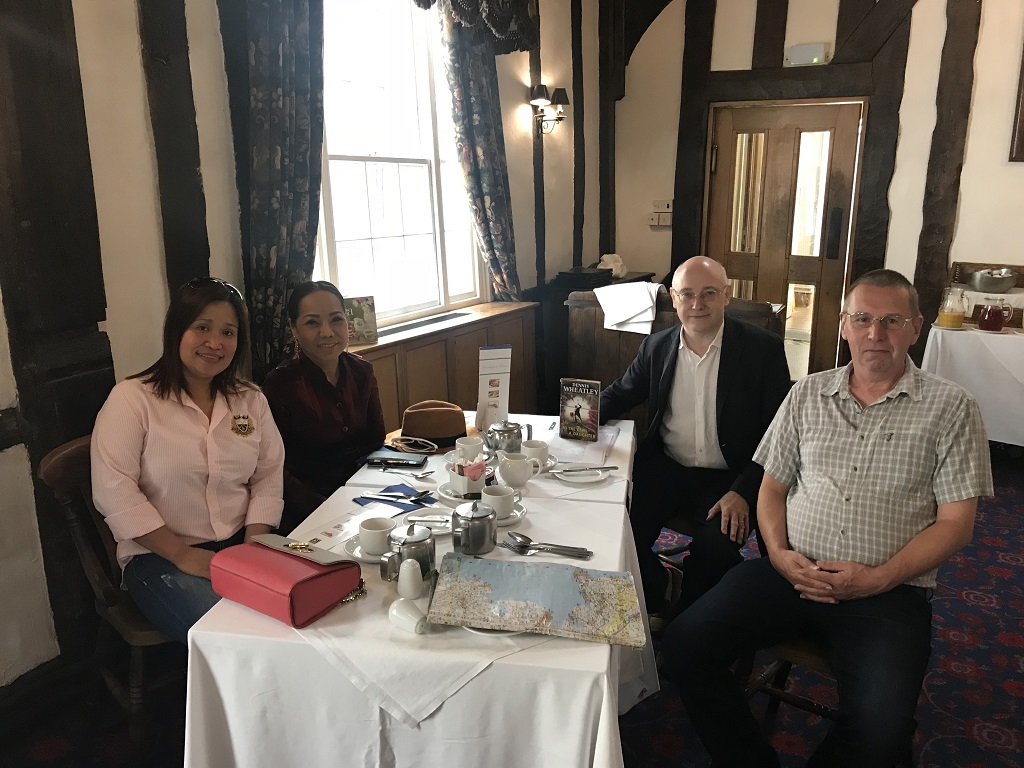
Charles and the excellent Dan (left); Golda, Nat, Charles, Mike (right)
Click on the image to enlarge
The hotel was under-staffed but so pleasantly staffed that I would have had it no other way. The only person on duty (at least, that we saw), was the excellent Dan, who took an interest in why we were there (he had not heard of Dennis Wheatley) and staffed the bar and the restaurant and met every request we made with a most cheerful and helpful disposition. Dan – I hope you are still there when we next visit, and thank you !
The four of us met up at breakfast on the Saturday morning, Nat and I a little bleary eyed due to ‘revelling-by-proxy’, we made our way to our cars (parking is some way from the hotel, except for disabled visitors) and made our way to the Bricklayers Arms in Little Bentley. We should have made our way to the Weavers Arms in Little Benford, but unfortunately Little Benford does not exist (a prank DW also played in The Devil Rides Out, where every place is faithfully and accurately recorded, except the mythical Chilbury, which is possibly an anonymised version of Heytesbury. It is possible that when DW had friends living in a small village he featured in one of his novels, he deliberately changed its name out of sensitivity). Oldjiver plausibly suggested that the real location is the Bricklayers Arms in Little Bentley, and Mike and I thought the description looked right enough – there was a triangular green outside the pub and various other bits tallied.
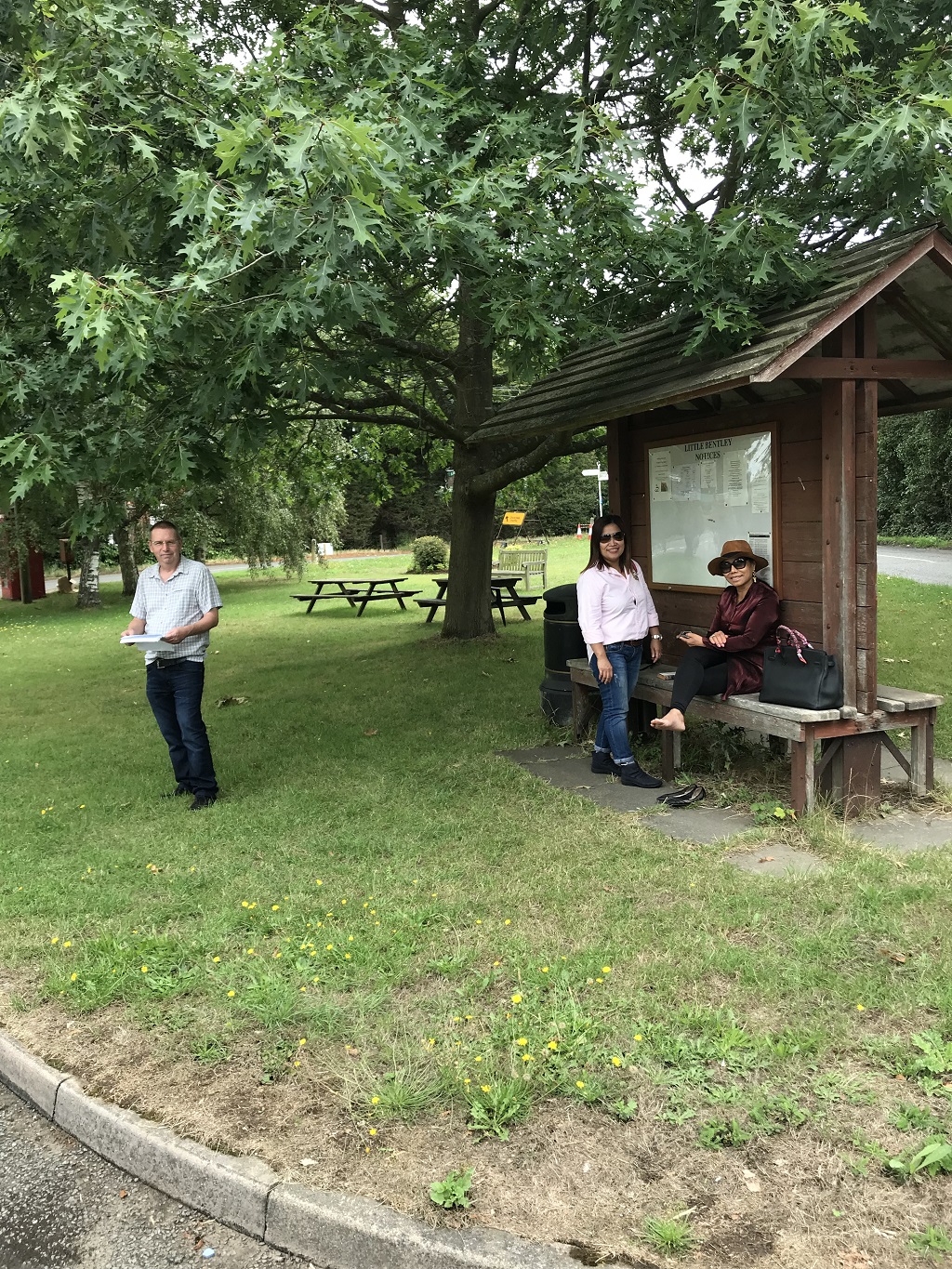
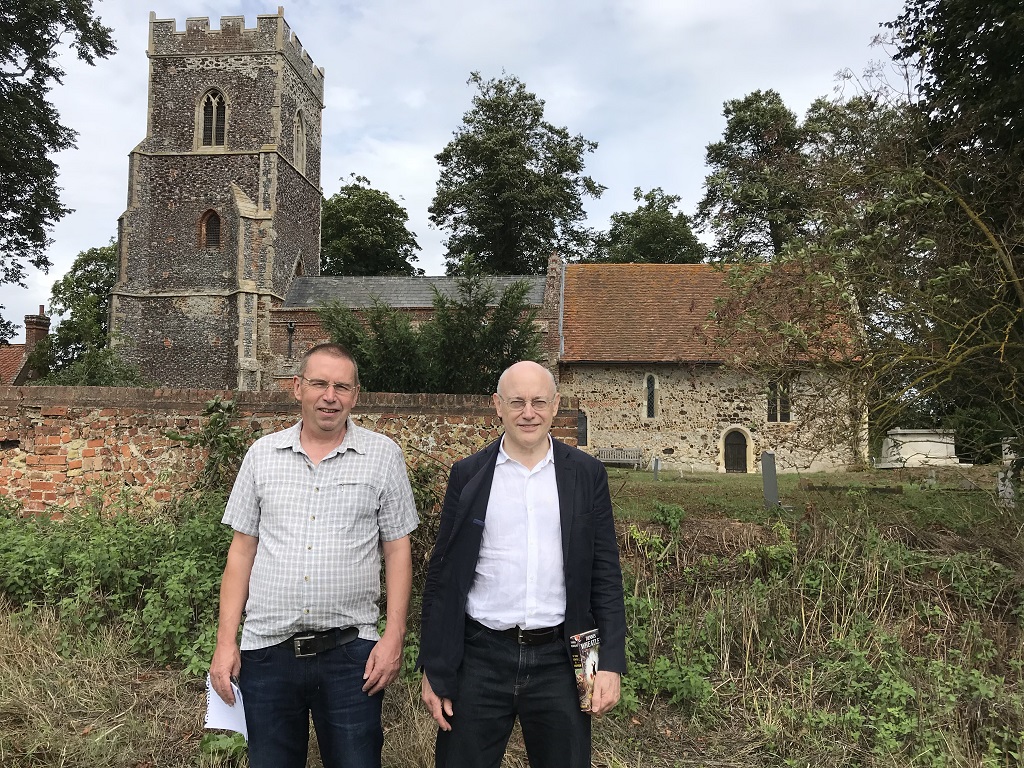
The triangular green at Little Bentley (left) and the Church of St Mary
Click on the image to enlarge
We would have had lunch there but they were fully booked. A tip for next time – book early. The restaurant is very popular.
From there we took the short drive to the Church of Saint Mary; a slightly odd church with parts dating from the 13th century. The nave roof is made of the original medieval timber, and features rows of beams carved into angels, but with the heads cut off during the Civil War by Puritan iconoclasts. It gives a rather weird effect to the building. Mike and I rather liked a short stone stairway cut into the wall behind the pulpit which led … precisely nowhere. Rather spooky.
There was a post box near the church, and this fitted in nicely with the suggestion that the Priory where Canon Copely-Syle lived was one of the buildings opposite. Indeed we chatted to the owner of the most likely house, who was somewhat distracted because a tree had fallen the night before and felled his power line, and so he was without electricity. He had wondered why the odd person had – somewhat rudely and without explanation – poked their nose a little too close to his house for comfort – and we were able to explain why. I’m not sure this brought him a great deal of comfort (the average person might not react too well to the news that their house might have been used in fiction as the home of a decidedly unpleasant man who was trying to grow a homunculus; I think I might well react in just the same way, depending on the author). Anyway, and with apologies for disturbing him, I send him the reference afterwards so at least he would know what was going on if anyone in the future so rudely accosted him.
Our readers – if you are visiting, please don’t be intrusive and knock on his door or peer through his windows or anything like that, and if you happen to meet him in the lane, please be very respectful – Thank You !
From there- and to keep a long story short, and so as not to ruin your fun if you visit on your own or if we go on a Field Trip – Mike and I managed to get lost several times (yes, you can imagine swirls of phantom mist assailing us ..) but managed to end up at Hanford Water, to see where the Canon might have taken his adieu of his pursuers en route for the South of France and his later fragmentation.
It was a good trip and I think Mike and I would both recommend a Field Trip at some stage (and Mike and Golda – thank you a million times for all your own research and preparations, and for being the perfect hosts on the day).
Mike’s suggestions, which I read out for him (or I think I did) at the last Convention, are :
For those staying overnight at the Red Lion at Colchester or who want to start from there the journey takes about half an hour to Little Bentley, so perhaps arrange to get to Little Bentley by ten a.m.
Potter about at Little Bentley, have a look at Bricklayers Arms (possibly the Weavers Arms?), travel the short distance up the road to see the church with the ‘squat square tower’ (St Mary’s), see (discreetly and without please in any way disturbing the very nice owner) Bentley Manor (possibly the Priory), then progress a little further on to Warren Farm (by a ‘blind turning’ and possibly the model for The Grange). Look for other possible candidates for The Grange? This will all take couple of hours at a leisurely pace.
Possibly return to Little Bentley and the Bricklayers Arms for lunch depending on space being available in the restaurant (pre-booking essential – at least at the time of writing).
After lunch, head off to Great Oakley by Hanford Water, the most likely site for the seaplane landing, given the distances mentioned in the novel and discussed by OJ. The journey will take about half an hour, passing through Weeley and Thorpe Le Soken. Flag down Joe Cotton if anyone sees him and ask him what he’s been up to.
Park at the visitor centre and tea room at Great Oakley. Track from the tearoom into the marshes; closed by a difficult farmer who doesn’t like trespassers, but there is a track a little down the main road which has public access if anyone wants a short walk in the marshes.
Have a cup of tea (or two) in the tearoom to finish the trip, by which time it will likely be about 4 p.m.
This page last updated Copyright © 2002-2006 Bob Rothwell. 2007-2025 Charles Beck.